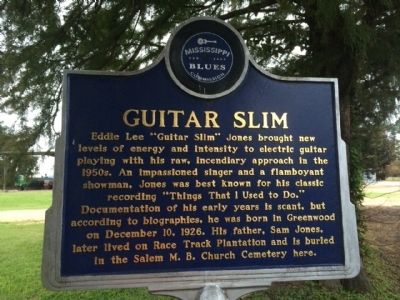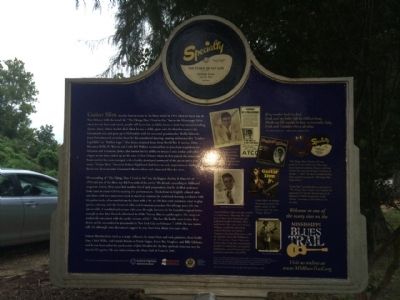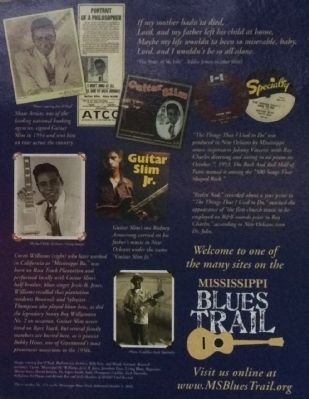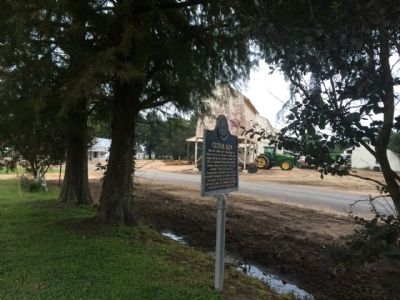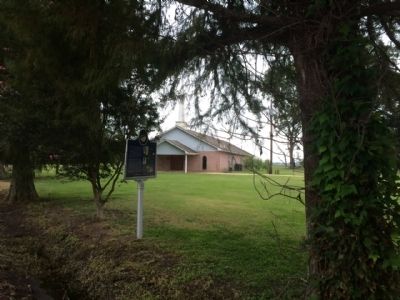Near Greenwood in Leflore County, Mississippi — The American South (East South Central)
Guitar Slim
Front
Eddie Lee “Guitar Slim” Jones brought new levels of energy and intensity to electric guitar playing with his raw, incendiary approach in the 1950s. An impassioned singer and a flamboyant showman, Jones was best known for his classic recording "Things That I Used To Do." Documentation of his early years is scant, but according to biographies, he was born in Greenwood on December 10, 1926. His father, Sam Jones, later lived on Race Track Plantation and is buried in the Salem M. B. Church Cemetery here.
Rear
Guitar Slim was the hottest name in the blues world in 1954 when he burst out of New Orleans with the smash hit “The Things That I Used to Do,” but in the Mississippi Delta where he was born and raised, people still knew him as Eddie Jones, a choir boy turned jitterbug dancer. Jones, whose mother died when he was a child, spent only his first few years in the Greenwood area and grew up in Hollandale with his maternal grandmother Mollie Edwards. Jones first attracted attention there for his sensational dancing, earning nicknames like “Limber Leg Eddie” or “Rubber Legs.” After Jones returned home from World War II service, Delta bluesmen Willie D. Warren and Little Bill Wallace recruited him to join them to perform in Arkansas and Louisiana. Jones, also known for his ability to imitate Louis Jordan and other singers at the time, ended up on his own in New Orleans where he first played the streets and house parties but soon emerged with a freshly developed command of the guitar and a new name, “Guitar Slim.” Guitarist Robert Nighthawk had been an early inspiration in Hollandale, but it was Texas maestro Gatemouth Brown whose style impacted Slim the most.
His recording of “The Things That I Used to Do” was the biggest rhythm & blues hit of 1954 and one of the three top R&B records of the entire ‘50s decade, according to Billboard magazine. Guitar Slim never had another hit of such proportions, but he thrilled audiences from coast to coast with his exciting live performances. Decked out in brightly colored suits and shoes with hair sometimes dyed to match or contrast, he combined dancing acrobatics with his guitar work, often strolled out the door with a 50- to 350-foot cord (estimates vary) to play guitar, and sang with the fervor of a fire-and-brimstone preacher. His offstage party life was just as wild. A troubled and serious side came through, however, in his heartfelt original lyrics, enough so that Atco Records advertised in 1958: “Guitar Slim is a philosopher. His songs are exclusively concerned with the earthy truisms of life.” The fast life finally wore Guitar Slim down and he succumbed to pneumonia in New York City on February 7, 1959. He was reportedly 32, although some documents suggest he may have been about two years older.
Guitar Slim has been cited as a major influence by many blues and rock guitarists, from Buddy Guy, Chick Willis, and Lonnie Brooks to Frank Zappa, Stevie Ray Vaughan, and Billy Gibbons, and he has been called the predecessor of Jimi Hendrix for the free-spirited, ferocious way he attacked his guitar. He was inducted into the Blues Hall of Fame in 2007.
Erected 2010 by the Mississippi Blues Commission. (Marker Number 114.)
Topics and series. This historical marker is listed in these topic lists: African Americans • Arts, Letters, Music • Entertainment. In addition, it is included in the Mississippi Blues Trail series list. A significant historical date for this entry is February 7, 1959.
Location. 33° 33.54′ N, 90° 14.211′ W. Marker is near Greenwood, Mississippi, in Leflore County. Marker is on County Road 101, 1˝ miles east of U.S. 49E, on the left when traveling north. Heading north on US 49E take a right at the County Roads 539/101 intersection onto CR 101. Touch for map. Marker is at or near this postal address: 6712 County Road 101, Greenwood MS 38930, United States of America. Touch for directions.
Other nearby markers. At least 8 other markers are within 4 miles of this marker, measured as the
crow flies. Robert Johnson (approx. 1.3 miles away); Fort Pemberton Park (approx. 2 miles away); Bobbie Gentry (approx. 2.9 miles away); Sgt. John A. Pittman (approx. 2.9 miles away); Hubert Sumlin (approx. 3.4 miles away); Old Greenwood Cemetery (approx. 3.9 miles away); Confederate Memorial Plot (approx. 3.9 miles away); Greenwood (approx. 4 miles away). Touch for a list and map of all markers in Greenwood.
Also see . . .
1. Guitar Slim Biography. (Submitted on September 17, 2014, by Mark Hilton of Montgomery, Alabama.)
2. Mississippi Blues Trail. (Submitted on September 17, 2014.)
Credits. This page was last revised on June 16, 2016. It was originally submitted on September 17, 2014, by Mark Hilton of Montgomery, Alabama. This page has been viewed 484 times since then and 50 times this year. Photos: 1, 2, 3, 4, 5. submitted on September 17, 2014, by Mark Hilton of Montgomery, Alabama. • Bernard Fisher was the editor who published this page.
